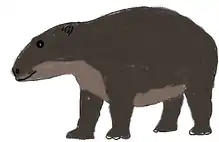Megalohyrax
Megalohyrax is an extinct hyrax-grouped genus of herbivorous mammal from the Lower Oligocene, about 33–30 million years ago. Its fossils have been found in Africa and in Asia Minor.
| Megalohyrax | |
|---|---|
 | |
| Scientific classification | |
| Kingdom: | |
| Phylum: | |
| Class: | |
| Order: | |
| Family: | |
| Subfamily: | †Saghatheriinae |
| Genus: | †Megalohyrax Andrews, 1903 |
| Species: | M. lavocati |
| Binomial name | |
| Megalohyrax eocaenus Andrews, 1903 | |
| Synonyms | |
|
Mixohyrax Schlosser, 1910 | |
Description
This animal was very different from the current hyraxes and much larger, generally reaching the size of a tapir and sometimes exceeding 1.5 meters in length. The legs were strong and the body very massive. The skull was long and low, unlike that of today's hyraxes, and could reach 40 centimeters in length. The dental formula of Megalohyrax was composed of three incisors, one canine, four premolars and three molars.
Classification
It was first described by Andrews in 1903. The type species is Megalohyrax eocaenus, was found in the El Fayum area in Egypt. Other fossils attributed to this kind have been found in Saudi Arabia and Ethiopia.
References
- Andrews, CW 1903. "Notes on an expedition to the Fayum, Egypt, with descriptions of some new mammals". Geological Magazine 4: 337–343.
- CW Andrews. 1906. A Descriptive Catalogue of the Tertiary Vertebrata of Fayum, Egypt 1–324
- J. Sudre. 1979. "Nouveaux MAMMIFERES eocenes du Sahara occidental". Palaeovertebrata 9 (3): 83–115
- DT Rasmussen and EL Simons. 1988. "New Oligocene hyracoids from Egypt". Journal of Vertebrate Paleontology 8 (1): 67–83
- JGM Thewissen, Simons EL (2001) "Skull of Megalohyrax eocaenus (Hyracoidea, Mammalia) from the Oligocene of Egypt". Journal of Vertebrate Paleontology 21: 98–106.
- J. Kappelman, DT Rasmussen, WJ Sanders, M. Feseha, T. Bown, P. Copeland, J. Crabaugh, J. Fleagle, M. Glantz, A. Gordon, B. Jacobs, M. Maga, K. Muldoon, A. Pan, L. Pyne, B. Richmond, T. Ryan, ER Seiffert, S. Sen, L. Todd, MC Wiemann and A. Winkler. 2003. "Oligocene mammals from Ethiopia and faunal exchange between Afro-Arabia and Eurasia". Nature 426: 549–552


